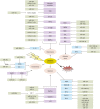Emerging Roles of microRNAs in Ischemic Stroke: As Possible Therapeutic Agents
- PMID: 28480877
- PMCID: PMC5466283
- DOI: 10.5853/jos.2016.01368
Emerging Roles of microRNAs in Ischemic Stroke: As Possible Therapeutic Agents
Abstract
Stroke is one of the leading causes of death and physical disability worldwide. The consequences of stroke injuries are profound and persistent, causing in considerable burden to both the individual patient and society. Current treatments for ischemic stroke injuries have proved inadequate, partly owing to an incomplete understanding of the cellular and molecular changes that occur following ischemic stroke. MicroRNAs (miRNA) are endogenously expressed RNA molecules that function to inhibit mRNA translation and have key roles in the pathophysiological processes contributing to ischemic stroke injuries. Potential therapeutic areas to compensate these pathogenic processes include promoting angiogenesis, neurogenesis and neuroprotection. Several miRNAs, and their target genes, are recognized to be involved in these recoveries and repair mechanisms. The capacity of miRNAs to simultaneously regulate several target genes underlies their unique importance in ischemic stroke therapeutics. In this Review, we focus on the role of miRNAs as potential diagnostic and prognostic biomarkers, as well as promising therapeutic agents in cerebral ischemic stroke.
Keywords: Ischemia; MicroRNAs; Stroke.
Conflict of interest statement
The authors have no financial conflicts of interest.
Figures



Similar articles
-
The Interplay of MicroRNAs in the Inflammatory Mechanisms Following Ischemic Stroke.J Neuropathol Exp Neurol. 2017 Jul 1;76(7):548-561. doi: 10.1093/jnen/nlx036. J Neuropathol Exp Neurol. 2017. PMID: 28535304 Review.
-
Can miRNAs Be Considered as Diagnostic and Therapeutic Molecules in Ischemic Stroke Pathogenesis?-Current Status.Int J Mol Sci. 2020 Sep 14;21(18):6728. doi: 10.3390/ijms21186728. Int J Mol Sci. 2020. PMID: 32937836 Free PMC article. Review.
-
microRNAs: innovative targets for cerebral ischemia and stroke.Curr Drug Targets. 2013 Jan 1;14(1):90-101. doi: 10.2174/138945013804806424. Curr Drug Targets. 2013. PMID: 23170800 Free PMC article. Review.
-
The emerging roles of microRNAs in CNS injuries.Nat Rev Neurol. 2013 Jun;9(6):328-39. doi: 10.1038/nrneurol.2013.67. Epub 2013 Apr 16. Nat Rev Neurol. 2013. PMID: 23588363 Free PMC article. Review.
-
The role of non-coding RNAs in neuroprotection and angiogenesis following ischemic stroke.Metab Brain Dis. 2020 Jan;35(1):31-43. doi: 10.1007/s11011-019-00485-2. Epub 2019 Aug 24. Metab Brain Dis. 2020. PMID: 31446548 Review.
Cited by
-
Mesenchymal Stem Cell-Mediated Mitochondrial Transfer: a Therapeutic Approach for Ischemic Stroke.Transl Stroke Res. 2021 Apr;12(2):212-229. doi: 10.1007/s12975-020-00853-6. Epub 2020 Sep 25. Transl Stroke Res. 2021. PMID: 32975692 Review.
-
Epigenetic reprogramming of immune cells in injury, repair, and resolution.J Clin Invest. 2019 Jul 22;129(8):2994-3005. doi: 10.1172/JCI124619. eCollection 2019 Jul 22. J Clin Invest. 2019. PMID: 31329166 Free PMC article. Review.
-
The expression of microRNA 146a in patients with ischemic stroke: an observational study.Int J Gen Med. 2019 Aug 9;12:273-278. doi: 10.2147/IJGM.S213535. eCollection 2019. Int J Gen Med. 2019. PMID: 31496785 Free PMC article.
-
The Potential Role of MicroRNA-124 in Cerebral Ischemia Injury.Int J Mol Sci. 2019 Dec 23;21(1):120. doi: 10.3390/ijms21010120. Int J Mol Sci. 2019. PMID: 31878035 Free PMC article. Review.
-
Alkaline phosphatase: a potential biomarker for stroke and implications for treatment.Metab Brain Dis. 2019 Feb;34(1):3-19. doi: 10.1007/s11011-018-0322-3. Epub 2018 Oct 4. Metab Brain Dis. 2019. PMID: 30284677 Free PMC article. Review.
References
-
- Heron M. Deaths: leading causes for 2004. Natl Vital Stat Rep. 2007;56:1–96. - PubMed
-
- Centers for Disease Control and Prevention (CDC) Prevalence of disabilities and associated health conditions among adults--United Sstates, 1999. Morb Mortal Wkly Rep. 2001;50:120–125. - PubMed
-
- World Health Organization . The World health report 2004: changing history. Geneva: World Health Organization; 2004.
-
- Mukherjee D, Patil CG. Epidemiology and the global burden of stroke. World Neurosurg. 2011;76(6 Suppl):S85–S90. - PubMed
-
- Beal CC. Gender and stroke symptoms: a review of the current literature. J Neurosci Nurs. 2010;42:80–87. - PubMed
Publication types
LinkOut - more resources
Full Text Sources
Other Literature Sources
Research Materials

